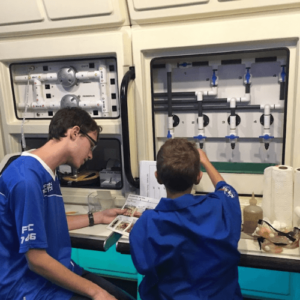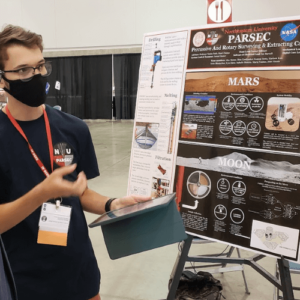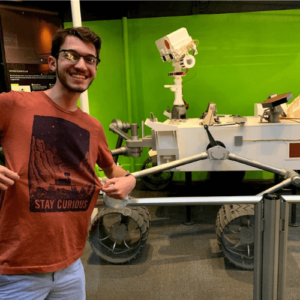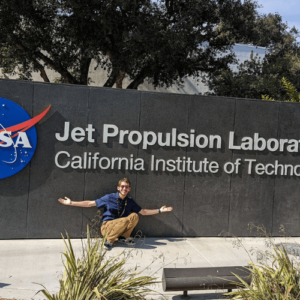Robotics Engineering Graduate Intern, NASA Jet Propulsion Lab
Challenger Center Sparked a Lifelong Dream of Robotics Engineering
Challenger Learning Center in New York
Ethan Holand, a graduate intern in robotics engineering at NASA’s Jet Propulsion Laboratory (JPL), is currently working on the landing gear that’ll be used in the Mars Sample Return Mission. He’s conducting tests to measure loads, accelerations, and displacements during simulated landing conditions. He’ll soon be part of the team that will design the footpads for the lander’s flight hardware.
This past spring, Ethan graduated from Northeastern University with a Bachelor of Science in Mechanical Engineering. As a campus leader, he relaunched NURobotics, a student-driven robotics club that went dormant during the COVID-19 pandemic. Thanks to his passion for robotics and a thirst for creating a welcoming and collaborative community, NURobotics reached 450 members that developed eight robots under his leadership.
This upcoming fall, Ethan will continue his robotics journey at Carnegie Mellon University through their Master of Science in Robotics program. His dream is to develop robots for unvisited worlds where challenging terrain guards a potential for life beyond our own.
But what sparked his interest in STEM and robotics that led him down this incredible path? Ethan traces the start of his journey back to Challenger Center…
How did your Challenger Learning Center experiences ignite your passion for STEM?
 Visiting my town’s Challenger Learning Center was a pivotal experience. Participating in Lego robotics programs, learning about space missions, participating in space-themed camps, and even celebrating my eleventh birthday on a mission to the Moon created lasting memories. I even came back as captain of my high school robotics team to volunteer during a mission.
Visiting my town’s Challenger Learning Center was a pivotal experience. Participating in Lego robotics programs, learning about space missions, participating in space-themed camps, and even celebrating my eleventh birthday on a mission to the Moon created lasting memories. I even came back as captain of my high school robotics team to volunteer during a mission.
During summer camp one year, I learned about NASA’s Mars Curiosity rover. Later, I taped a picture of the rover beside my desk and my dreamed about working at NASA. Ten years later, I work alongside the engineers who designed that rover to support the next Mars mission. Now, I dream my work will inspire the next generation.
How did this impact your educational and professional experiences?
 As I entered Northeastern University, I never lost sight of my passion for space. I found a community of similar individuals on the university’s NASA Mars Ice Challenge team. With a crew of six scrappy freshmen, we learned how to build a robot by trial and error. Unfortunately, we couldn’t see the fruits of our development when the onset of the pandemic canceled the competition.
As I entered Northeastern University, I never lost sight of my passion for space. I found a community of similar individuals on the university’s NASA Mars Ice Challenge team. With a crew of six scrappy freshmen, we learned how to build a robot by trial and error. Unfortunately, we couldn’t see the fruits of our development when the onset of the pandemic canceled the competition.
In our second year, we welcomed a new batch of eager freshmen to the team. As Mechanical Lead, I guided them in designing the next iteration of our robot prototype that would extract drinkable water from subsurface Martian ice. At the competition, we presented to NASA engineers and received Best Technical Paper and 2nd Overall awards, surpassing expectations for a team of freshmen and sophomores.
For my final co-op, I achieved my childhood dream and found myself at JPL. I was in awe and felt honored to work alongside the engineers who designed the rovers that inspired my younger self. Together, we’ve started building the next Mars mission. I credit this opportunity to my practical experience designing prototype space systems on the Mars Ice Challenge team.
Can you tell us about your experience with robotics at Northeastern?
 When I started my bachelor’s degree in 2019, I discovered a relatively small robotics club. Unfortunately, without being able to get together in person during the pandemic, the club collapsed. But when classes became hybrid and we were able to meet again, I gathered a group of students to rebuild the club.
When I started my bachelor’s degree in 2019, I discovered a relatively small robotics club. Unfortunately, without being able to get together in person during the pandemic, the club collapsed. But when classes became hybrid and we were able to meet again, I gathered a group of students to rebuild the club.
We secured a maker space, equipped it with 3D printers and hardware, and initiated various robotics projects, including mini battle bots and underwater robots. In two years, our club grew from being completely inactive to more than 450 members by the time I passed on the presidency to the next student.
The value of hands-on experience, especially in robotics, is immeasurable. Robotics can be intimidating because of the intersection of mechanical, electrical, and software engineering. It was important for us to be able to get together in a team format because no one person has all that knowledge. It was our way to gain experience, build bonds with peers, and learn how to work on a team.
It was especially important for us to make the club accessible to everyone—no matter a student’s educational background. If someone came to us with zero experience, we supported them with an intro to robotics course—teaching along the way. Inclusion was a main pillar of our club.
To this day, building and witnessing the club’s success is a huge accomplishment of mine.
How have you inspired the next generation through Challenger Center?
 One of the most rewarding moments I’ve had in recent years was going back to my Challenger Learning Center and reconnecting with the director. I had the opportunity to teach the very same Lego robotics class that I had attended years ago. I shared info with students about the upcoming Mars missions that I was working on at NASA and how I’d started out just like them. Just a decade earlier, I was in their seats. Now, as a NASA intern, I’m helping them assemble the kits I once built.
One of the most rewarding moments I’ve had in recent years was going back to my Challenger Learning Center and reconnecting with the director. I had the opportunity to teach the very same Lego robotics class that I had attended years ago. I shared info with students about the upcoming Mars missions that I was working on at NASA and how I’d started out just like them. Just a decade earlier, I was in their seats. Now, as a NASA intern, I’m helping them assemble the kits I once built.
In this moment, I felt like my entire educational journey had come full circle. The Center’s programs and initial exposure to engineering and robotics set me on the path of exploration and shaped my passion for STEM.
Why do you believe STEM education is important for young people?
I think that STEM is more than just a collection of subjects; it’s a problem-solving mindset that can be helpful in all aspects of life. Even if students don’t want to pursue a career in STEM, teaching young kids to think critically, ask questions, and find innovative solutions will always be beneficial to them as they grow up.
STEM teaches kids to be curious. Whenever my class would take a field trip to a museum, I was the kid who lagged behind because I was trying to read every single sign . . . and I still do it! There’s always more to learn. Being curious about how the world works is really what led me on the path I’m today. STEM education is empowering
